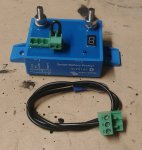the "IN" side includes everything up to the battery. so directly to the battery, a special sub panel for charging, whatever you want.. as long as its on the IN side of the circuit and not the OUT, I didnt mean on the terminals directly, sorry for the confusion.. so yeah, the battery is fine if your fusing it inline correctly.
Yeah that black cable w/ring terminal is the ground for the BP, that loop thats plugged in is the remote IO.. its gotta be connected to turn on, open to turn off.. its just looped to be always on, you can yank it out and it'll shut off if you want manual control.. the other unused screw terminals are for manual programming and I think LED/Buzzer output.
If you take that loop out, run a small pair of wire from that terminal post to the COM and NC (Normally Closed) ports on the back of your BMV.. you then can configure relay alarm output in BMV to open that circuit and shutoff loads with the varying configuration options the Victron BT app gives you.. such as low state of charge, high/low voltage, high/low temps (if you got temp monitoring)



